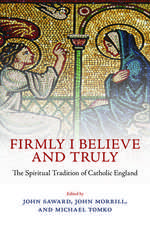After Anti-Catholicism?: John Henry Newman and Protestant Britain, 1845-c. 1890
Autor Dr. Erik Sidenvallen Limba Engleză Hardback – 9 dec 2005
Preț: 771.52 lei
Preț vechi: 1139.72 lei
-32% Nou
Puncte Express: 1157
Preț estimativ în valută:
147.65€ • 151.21$ • 122.82£
147.65€ • 151.21$ • 122.82£
Carte tipărită la comandă
Livrare economică 18 martie-01 aprilie
Preluare comenzi: 021 569.72.76
Specificații
ISBN-13: 9780567030764
ISBN-10: 0567030768
Pagini: 222
Dimensiuni: 138 x 216 x 22 mm
Greutate: 0.4 kg
Editura: Bloomsbury Publishing
Colecția T&T Clark
Locul publicării:London, United Kingdom
ISBN-10: 0567030768
Pagini: 222
Dimensiuni: 138 x 216 x 22 mm
Greutate: 0.4 kg
Editura: Bloomsbury Publishing
Colecția T&T Clark
Locul publicării:London, United Kingdom
Cuprins
Introduction 1. Varieties of anti-Catholicism 2. Meaning and Metaphor 3. Breaking the anti-Catholicism Ascendancy 4. Tensions within Anglo-Catholicism 5. Final Contradictions Conclusion
Recenzii
'Erik Sidenvall's book offers a new and intriguing perspective on Victorian religion, the role of anti-Catholicism, and the rise of toleration within English society...Erik Sidenvall's book is an important addition to Newman scholarship and British religious history. His insights into public opinion, the issue of religious conversion, and the relationship of prejudice and toleration are important elements in appreciating the dynamics of Victorian religion and the challenges of today's world where bigotry and intolerance still exist.' Rene Kollar, Saint Vincent Archabbey, Latrobe, PA, Heythrop Journal
'Religious controversy was practically a staple of Victorian life. This study, originally a doctoral dissertation at the University of Lund (Sweden), investigates the emergence of religious tolerance in nineteenth-century Britain by examining the public reaction to pivotal events in the life of John Henry Newman (1801-90). Although Newman was no stranger to controversy during his Anglican years, his "secession" from the Church of England to Roman Catholicism in 1845 unleashed a tidal wave of anti-Catholicism. Two decades later, in contrast, the publication of his Apologia pro vita sua (1864) evoked more tolerant and less prejudicial attitudes. By the time of his death (1890), the "great apostate" of 1845 was regarded in many circles as "the revered lion of culture and sublime religious sentiment." In the author's historical analysis, this shift in attitudes was certainly not universal but represents a complex, even sometimes contradictory political- social symbiosis of an expanding religious tolerance with a still deep-seated and thus far from defunct anti-Catholicism. Even though some may have reservations about Sidenval's main thesis about the dynamics and dimensions of Victorian toleration, readers will benefit greatly from this book's detailed information and numerous insights based on extensive research into primary sources, particularly Victorian periodicals. This book, written in clear, crisp, and cogent prose, is a "must read" for all those interested in Victorian religious history, especially Newmanists.' John T. Ford The Catholic University of America
'Religious controversy was practically a staple of Victorian life. This study, originally a doctoral dissertation at the University of Lund (Sweden), investigates the emergence of religious tolerance in nineteenth-century Britain by examining the public reaction to pivotal events in the life of John Henry Newman (1801-90). Although Newman was no stranger to controversy during his Anglican years, his "secession" from the Church of England to Roman Catholicism in 1845 unleashed a tidal wave of anti-Catholicism. Two decades later, in contrast, the publication of his Apologia pro vita sua (1864) evoked more tolerant and less prejudicial attitudes. By the time of his death (1890), the "great apostate" of 1845 was regarded in many circles as "the revered lion of culture and sublime religious sentiment." In the author's historical analysis, this shift in attitudes was certainly not universal but represents a complex, even sometimes contradictory political- social symbiosis of an expanding religious tolerance with a still deep-seated and thus far from defunct anti-Catholicism. Even though some may have reservations about Sidenval's main thesis about the dynamics and dimensions of Victorian toleration, readers will benefit greatly from this book's detailed information and numerous insights based on extensive research into primary sources, particularly Victorian periodicals. This book, written in clear, crisp, and cogent prose, is a "must read" for all those interested in Victorian religious history, especially Newmanists.' John T. Ford The Catholic University of America












